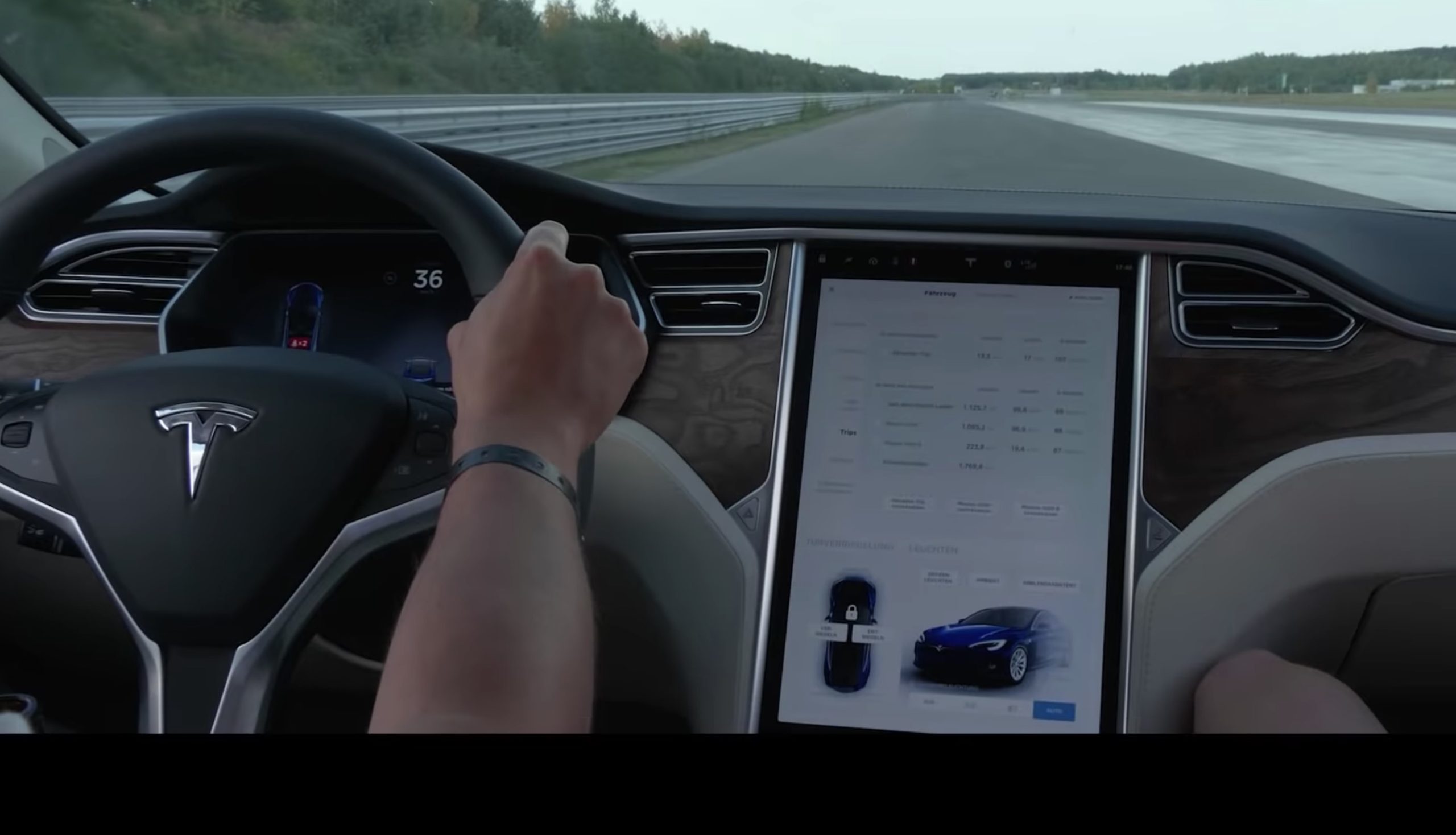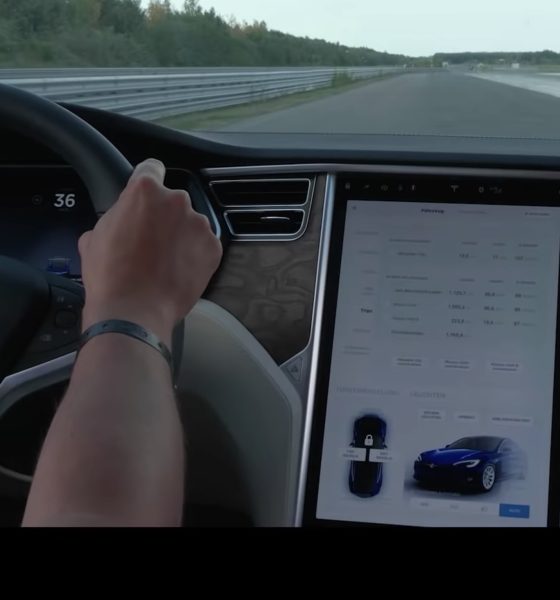

Lifestyle
Tesla Model S, Model 3 set hypermile records: 701 mi. (1128 km) and 623 mi. (1001 km), respectively
German car rental company nextmove recently set a new hypermile record for the Tesla Model S, traveling a total of 701 miles (1,128 kilometers) on a single charge over more than 30 straight hours of driving at the DEKRA test circuit at Lausitzring in Brandenburg, Germany.
Being a car rental company, nextmove was quite familiar with Tesla’s electric cars. The company selected the Model S 100D as its car of choice for its hypermile attempt, and as could be seen in the video, a set of classic Aero Wheels for the full-sized all-electric sedan was also fitted on the vehicle. In a way, selecting the Model S 100D for the task is strategic, considering that the variant of the electric car has the highest EPA rating among Tesla’s offerings at 335 miles (539.1 km) per charge. In comparison, the EPA has a rating of 315 miles for the Model S 100D’s faster sibling and world’s quickest production car – the P100D.
The nextmove team was deliberate in its hypermile attempt to overtake the previous hypermile record set by another Model S 100D after it drove 670 miles (1,077 km) on a single charge. Last year’s feat, which was accomplished by Tesla Owners Italia, ultimately confirmed Elon Musk’s statement on Twitter that with the right tires, the Model S should be able to travel 1000 km in one charge. During its run, Tesla Owners Italia’s Model S 100D maintained an average of 91 Wh/km. On the latter parts of the journey, however, the electric car became even more efficient, hitting 88 Wh/km during the final 77 km of driving.
During nextmove’s recent attempt, the team immediately went for an average of 88 Wh/km, traveling at a constant speed of 38 kph (23.6 mph). According to nextmove Managing Director Stefan Moeller, the company’s car rental activities ultimately became practice for its record-setting hypermile run.
“As an electric car rental, we know many models very well from everyday practice. So we had a good sense of how long we could delay the ride in the end, without lying down. We managed to drive the Model S completely empty and come to a stop in the base camp directly at a loading facility,” he said.
The feat, however, did not come without challenges or discomforts. The hypermile attempt lasted a total of 31 hours, and to save on battery life, the vehicle’s windows were mostly closed and opened only for ventilation. No air conditioning was used, and the Model S 100D’s radio was not turned on as well. Autopilot was briefly used during the run, though nextmove stated that most of the steering was done by its drivers. Cruise control was utilized to control the vehicle’s speed to just 38 kph. By the time the drive was completed, the Model S 100D had traveled 1,128 kilometers (701 miles), with an average efficiency of 89 Wh/km.

A Tesla Model S 100D with Aero Wheels recently set a new hypermile record. [Credit: nextmove]
The quality of its battery packs and its vehicle’s range are among Tesla’s main strengths. Apart from the Model S, the nextmove team also set another record for the Model 3, traveling 623 miles (1,001 km) in a single charge. Unlike the Model S, however, the Model 3 accomplished its feat entirely on Autopilot, with a dummy on the driver’s seat simulating a driver.
While hypermiling does not really depict real-world driving scenarios, it is still quite impressive to see how far electric cars could travel when their efficiency and battery life are pushed to the limit. Earlier this year, two Tesla owners, Denver Tesla Club president Sean Mitchell and Erik Strait, a fellow Tesla owner and host to a popular YouTube channel, managed to squeeze as much as 606.2 miles (975.58 km) from a Model 3. Unlike nextmove, which did its hypermile run on a closed circuit, the two Tesla enthusiasts conducted their drive on public roads, simulating a more realistic driving scenario.
Watch nextmove’s record-setting hypermile run on the Tesla Model S 100D in the video below.

Lifestyle
Tesla Model S Plaid battles China’s 1500 hp monster Nurburgring monster, with surprising results
There is just something about Tesla’s tuning and refinement that makes raw specs seem not as game-changing.

The Tesla Model S Plaid has been around for some time. Today, it is no longer the world’s quickest four-door electric sedan, nor is it the most powerful. As per a recent video from motoring YouTube channel Carwow, however, it seems like the Model S Plaid is still more than a match for some of its newer and more powerful rivals.
The monster from China
The Xiaomi SU7 Ultra is nothing short of a monster. Just like the Model S Plaid, it features three motors. It also has 1,548 hp and 1,770 Nm of torque. It’s All Wheel Drive and weighs a hefty 2,360 kg. The vehicle, which costs just about the equivalent of £55,000, has been recorded setting an insane 7:04.957 at the Nurburgring, surpassing the previous record held by the Porsche Taycan Turbo GT.
For all intents and purposes, the Model S Plaid looked outgunned in Carwow’s test. The Model S Plaid is no slouch with its three motors that produce 1,020 hp and 1,420 Nm of torque. It’s also a bit lighter at 2,190 kg despite its larger size. However, as the Carwow host pointed out, the Model S Plaid holds a 7:25.231 record in the Nurburgring. Compared to the Xiaomi SU7 Ultra’s record, the Model S Plaid’s lap time is notably slower.
Real-world tests
As could be seen in Carwow’s drag races, however, Tesla’s tech wizardry with the Model S Plaid is still hard to beat. The two vehicles competed in nine races, and the older Model S Plaid actually beat its newer, more powerful counterpart from China several times. At one point in the race, the Xiaomi SU7 Ultra hit its power limit due to its battery’s temperature, but the Model S Plaid was still going strong.
The Model S Plaid was first teased five years ago, in September 2020 during Tesla’s Battery Day. Since then, cars like the Lucid Air Sapphire and the Xiaomi SU7 Ultra have been released, surpassing its specs. But just like the Model Y ended up being the better all-rounder compared to the BYD Sealion 7 and the MG IM6, there is just something about Tesla’s tuning and refinement that makes raw specs seem not as game-changing.
Check out Carwow’s Model S Plaid vs Xiaomi SU7 drag race video below.
Lifestyle
500-mile test proves why Tesla Model Y still humiliates rivals in Europe
On paper, the BYD Sealion 7 and MG IM6 promised standout capabilities against the Model Y.

BYD is seeing a lot of momentum in Europe, so much so that mainstream media has taken every opportunity to argue that the Chinese automaker has beaten Tesla in the region. But while BYD sales this year in Europe are rising and Tesla’s registrations remain challenged, the raw capabilities of vehicles like the Model Y are difficult to deny.
This was highlighted in a 500-mile challenge by What Car? magazine, which showed that the new Tesla Model Y is more efficient, cheaper to run, and more reliable than rivals like the BYD Sealion 7, and even the nearly 400 KW-charging MG IM6.
Range and charging promises
On paper, the BYD Sealion 7 and MG IM6 promised standout capabilities against the Model Y. The Sealion 7 had more estimated range and the IM6 promised significantly faster charging. When faced with real-world conditions, however, it was still the Model Y that proved superior.
During the 500-mile test, the BYD nearly failed to reach a charging stop, arriving with less range than its display projected, as noted in a CarUp report. MG fared better, but its charging speeds never reached its promised nearly-400 kW charging speed. Tesla’s Model Y, by comparison, managed energy calculations precisely and arrived at each stop without issue.
Tesla leads in areas that matter
Charging times from 25% to 80% showed that the MG was the fastest at 17 minutes, while Tesla and BYD were close at 28 and 29 minutes, respectively. Overall efficiency and cost told a different story, however. The Model Y consumed 19.4 kWh per 100 km, compared to 22.2 for MG and 23.9 for BYD. Over the full trip, Tesla’s charging costs totaled just £82 thanks to its supercharger network, far below BYD’s £130 and MG’s £119.
What Car? Magazine’s testers concluded that despite BYD’s rapid sales growth and the MG IM6’s seriously impressive charging speeds, Tesla remains the more compelling real-world choice. The Model Y just offers stability, efficiency, and a proven charging infrastructure through its Supercharging network. And as per the magazine’s hosts, the Model Y is even the cheapest car to own among the three that were tested.
Watch What Car? Magazine’s 500-mile test in the video below.
Lifestyle
Tesla Cybertruck slapped with world’s least intimidating ticket, and it’s pure cringe
One cannot help but cringe and feel second-hand embarrassment at the idea of a person just driving around with a stack of these babies.

A Cybertruck parked at Stanford Shopping Center in California was recently hit with what might be the most try-hard piece of paper ever slipped under a wiper blade: a “fake citation” accusing the driver of supporting a “fascist car.”
The note, shared on X by Tesla staff program manager Ryan Torres, quickly made the rounds on X, where it quickly gained attention as an example of how not to protest.
The world’s least intimidating ticket
According to the citation, the supposed “violation” was “driving a fascist car.” The remedial action? Take the bus, call an Uber, or ride a bike. The note also dubbed Elon Musk a “chainsaw-wielding Nazi billionaire.” Now, protests against Tesla and Elon Musk have become commonplace this year, but one cannot help but cringe and feel second-hand embarrassment at the idea of a person just driving around with a stack of fake anti-Tesla/Musk citations.
Torres pointed out the irony himself in his post on X. Tesla currently employs over 140,000 Americans, and SpaceX has put the U.S. firmly back at the top of space technology. As Torres put it, maybe the person behind the world’s least intimidating ticket should “read a book on innovation before vandalizing” other people’s property.
Peak performative clownery
Not to mention that the fake ticket’s logic collapses under its own weight. EVs like the Cybertruck are literally designed to reduce emissions, not “destroy the economy.” If anything, Tesla has bolstered the United States’ economy by fueling jobs in engineering, manufacturing, and clean energy. It’s not the first time a Tesla has been the target of vandalism or politically charged notes, but this one stands out for sheer cringe value.
Torres summed it up neatly: “Peak clownery.” On that point, at least, the citation earns full marks. In a way, though, perhaps cringe fake tickets are not as bad as the literal firebombs that were being thrown at Tesla stores and cars earlier this year because some critics were gleefully misinformed about Elon Musk.








